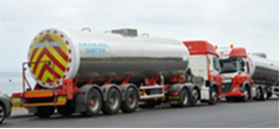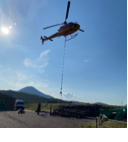Water, wastewater and drainage policy: consultation
This consultation seeks your views on our proposed principles and considerations in developing policy for the future of the water industry in Scotland in response to the climate emergency.
3. Drinking water
Safe drinking water is important to our health. Being able to turn on the tap and trust that you will have a safe, plentiful supply of water is often taken for granted in Scotland. A lot of work and your money goes into collecting, treating and distributing water taken from reservoirs, rivers and lochs to make sure that it is safe to drink.
The changing climate makes the availability and quality of water in the environment less reliable. Drought and flood make it harder to collect, treat and distribute water for drinking purposes. During floods or droughts some of the substances that usually stay in the mud at the bottom of our water sources go into the water making the quality worse. Similarly, if there is very heavy rain, pollutants can be washed into lochs, rivers and reservoirs. When the weather is warmer, algae is produced in the water. Algae can produce chemicals that make water smell musty and taste earthy. This makes the water more expensive to treat.
In addition to impacts from climate change there are other factors that impact on the quality of drinking water in homes. There are some areas across Scotland where it is likely that there are still lead pipes within homes that are taking drinking water to their taps. The lead can be released into the drinking water.
We need to make sure that we are able to provide a reliable supply of water during dry periods and act to protect the water supplies quickly during these times. We also need to make sure that the water that reaches our taps remains safe to drink, which requires us to consider all the possible risks. Whilst most of Scotland is served by a public supply of water there are some homes across Scotland that have private water supplies, which are especially vulnerable and we need to make sure that they are protected too.
3.1 Water availability
We rely on water for everything we do whether that be drinking, washing, cooking, watering our gardens, hygiene, growing food, building homes and businesses and making things. Forecasts suggest that, by 2050, during particularly dry periods, more than half of Scotland’s population will be at greater risk of water shortages. Some parts of Scotland may be more affected than others and at different times. The impacts of climate change, the trend in movement of population from west to east and economic growth, mean that there is a risk that there will not be enough drinking water to go around if we do not make changes.
In Scotland, the average person uses over 180 litres of tap water every day. This is higher than any other UK country and many European countries. In Germany, for example, the average person uses 125 litres every day. In Denmark they use 105 litres. Using less water in these countries is normal. This water is treated to a high standard for drinking, but we often use it for other purposes too. To reduce the amount of drinking water we use it could mean: showering for less time; installing a water butt[3]; using a watering can or bucket instead of a hose; installing products that do the same thing with less water (e.g. dishwashers); changing processes that might use more water than is needed; and building new homes and communities that use water more efficiently.
If we want to continue to use water at current rates, we will need to find an extra 2.3 million bathtubs’ worth of water every day. Most of this demand is projected to be in the east. This is the equivalent to the amount of water used in the Greater Glasgow water supply area. Treating water requires lots of energy to deliver the high quality water people expect in Scotland. To meet these future demands this would mean building new reservoirs, pipelines and treatment works, which is expensive, uses lots of carbon and is harmful to the environment. Alternatively, we can mitigate the impact of building to meet water demand by helping people and businesses to make better use of water. This may be in the appliances they use, or by considering how to be more efficient with the water they are using. These actions are already being taken but on a smaller scale than they might need to be in the future.
Currently, if we need to take emergency action to restrict water use (e.g. a hosepipe ban) during dry periods, to make sure everyone has enough water to drink, we need to consult the public for 21 days before the restrictions can apply. This means valuable time can be lost. An alternative would be to agree and publish a plan of pre-consulted actions that can be introduced swiftly when water supplies are low. With this option action could be taken more quickly to restrict water use and to conserve stocks. It would better protect rivers, help those who rely on using rivers to water crops, and protect the public water supply for essential use.


Questions
3. To what extent do you agree or disagree that everyone in Scotland needs to use less drinking water?
- Strongly agree
- Agree
- Neither agree nor disagree
- Disagree
- Strongly disagree
4. How do you think people and businesses could use less drinking water?
- [Free text]
5. Would you like to know how much water you use in your home?
- [Yes, No box]
6. Would you seek to reduce your water usage if this avoids building expensive new reservoirs and water treatment works?
- [Yes, No box]
7. Would you know where to find information on using less water?
- [Free text]
8. To what extent do you agree or disagree that the process for responding to water shortages should be changed so that appropriate action can be taken as soon as it is needed?
- Strongly agree
- Agree
- Neither agree nor disagree
- Disagree
- Strongly disagree
3.2 Water quality
In addition to the impacts that climate change can have on water quality there are other factors; in every property the plumbing materials can impact the quality of the water that comes out of the tap. Owners of the property are responsible for this. A particular issue in some areas of Scotland is the presence of lead within pipes in people’s homes, but it’s not the only risk that may arise now and in the future. Action is needed on a national scale to understand what and where these risks might be so that property owners can make informed decisions about their plumbing and how it impacts their water quality (a national assessment of risk).
Drinking water that contains lead can have a negative impact on a person’s health, particularly for children. Lead can be found in lots of different places, such as old paint, old water pipes, fixtures and fittings. Much has been removed from water systems today, but some still remains. Scottish Water adds a chemical, known as orthophosphate, to stop the lead dissolving in drinking water. Whilst orthophosphate is safe for human health it is a scarce resource, is not an environmentally friendly approach, and it will become more expensive as chemical supplies are limited. Replacing lead pipes, fixtures and fittings would fix this problem but it is expensive.
Questions
9. To what extent do you agree or disagree that all of Scotland’s plumbing should be made lead-free?
- Strongly agree
- Agree
- Neither agree nor disagree
- Disagree
- Strongly disagree
10. Would you know where to get information on how to ensure that your pipes are not affecting your drinking water?
- [yes /no]
3.3 Private water supplies
Private water supplies are drinking water supplies which are owned and managed by their users. There are 22,000 private water supplies which provide drinking water to 3% of Scotland’s population, plus many more visitors. Often these supply more rural properties. Unlike public supplies provided by Scottish Water, which are carefully monitored from catchment to tap, these smaller supplies are particularly vulnerable to the impacts of climate change (affecting the amount and quality of the water) and the way in which we use our land or any changes that we make to the land. We don’t always know where they are located. This could mean that damage can happen to pipework without the private water supply user knowing or it may be that changes to land use increase the risk of pollutants. A better understanding of how water sources are impacted by the changing climate and human activities is required to protect these supplies.
Private water supplies are owned by their owners and users. They can supply a single house, or even a whole community. There are currently two categories of private water supplies[4], based on the health risks they may pose to the people that use them. Each type is subject to different water quality checks requirements. This means that some 18,000 small supplies are rarely inspected by Local Authorities or monitored to check that the drinking water is safe.
Questions
11. Do you agree that all drinking water supplies, regardless of size or ownership, should be tested and inspected to ensure that drinking water is safe?
- Strongly agree
- Agree
- Neither agree nor disagree
- Disagree
- Strongly disagree
12. What support do owners and users of private water supplies require to ensure that drinking water is safe?
- [Free text]
13. Do you have any further views on public and private drinking water supplies?
- [free text]
Contact
Email: waterindustry@gov.scot
There is a problem
Thanks for your feedback